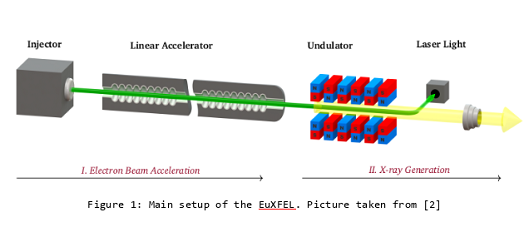URL: https://msk.desy.de/e88987/e333178/e333865/index_ger.html
Breadcrumb Navigation
Fault diagnosis for the LLRF control system
Introduction
The European X-ray Free Electron Laser (EuXFEL) [1] is a research facility at DESY that generates intense short pulses of X-ray light. It uses a linear accelerator comprises of 800 superconducting radio frequency (SRF) cavities to accelerate electrons to a very high energies up to 17.5 GeV (~27 000 flashes/second). These accelerated electrons are guided through a series of magnets called undulator, where X-ray radiation is emitted due to high speed oscillations. Figure 1 shows the setup of electron accelerator and X-ray generator at the EuXFEL.

Detecting anomalies at the accelerator level is crucial to ensure safe and efficient operation as well as to reduce the RF downtime caused by anomalies in the SRF cavity. One of anomalies that take place in the accelerator is cavity quench. Cavity quench happens when the area of the cavity walls become normal conductivity which result to a collapse of the accelerating field [3].
Our project use a model-based approach called parity space method [4] to detect not only cavity quench but also other anomalies. This method is derived from an analytical model with assumption that this model behave nominally in the system. Thus, deviation of the system (residual) from the model can provides different types of anomalies based on its signature. A statistical test is conducted using generalized likelihood ratio to evaluate the significant of residual’s deviation.
Purpose/goal/objectives:
· Protect the system from long RF downtime
· Classify different anomalies
· Predict anomalies, prevent failures
References:
- https://www.xfel.eu/facility/overview/index_eng.html
- A. Nawwaz, “Probabilistic Model-Based Anomaly Detection for the European X-Ray Free Electron Laser”, Dissertation, University of Luebeck, Luebeck, 2021.
- https://accelconf.web.cern.ch/icalepcs2013/papers/thppc072.pdf
- A. Eichler, J. Branlard, and J. H. K. Timm, “Anomaly Detection at the European XFEL using a Parity Space based Method”, Phys. Rev. Accel. Beams 26 (2023), no. 1, 012801, doi:10.1103/PhysRevAccelBeams.26.012801, arXiv:2202.02051


